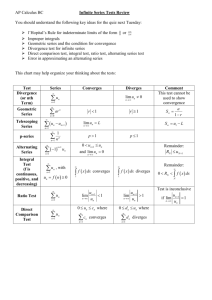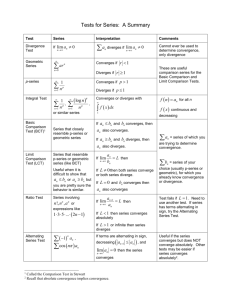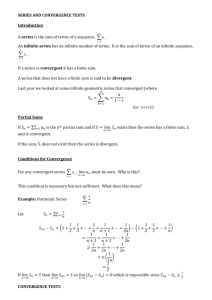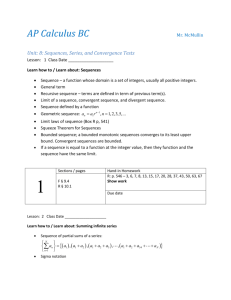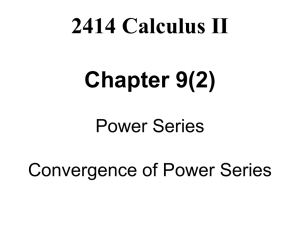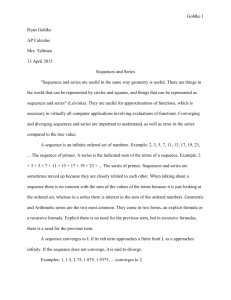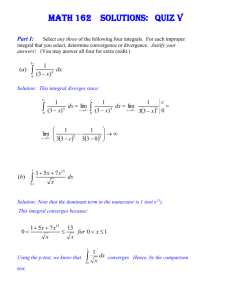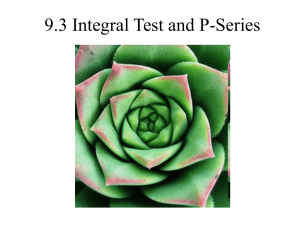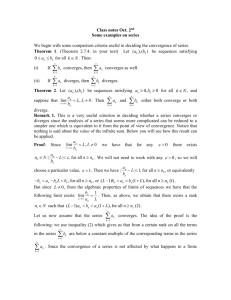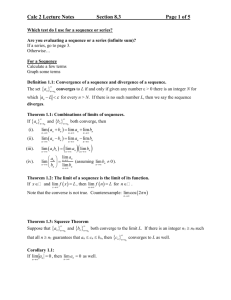Chapter 9(5) Alternating Series Test Alternating Series Remainder
advertisement
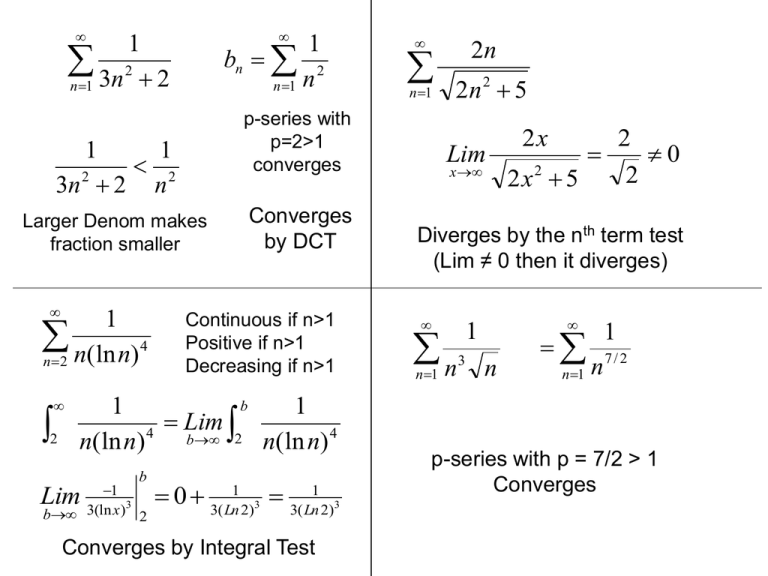
1 2 3 n 2 n 1 1 bn 2 n 1 n Larger Denom makes fraction smaller 1 4 n 2 n(ln n) 2 Converges by DCT Continuous if n>1 Positive if n>1 Decreasing if n>1 b 1 1 Lim n(ln n) 4 b 2 n(ln n) 4 b Lim 3(ln1x)3 0 3( Ln1 2)3 3( Ln1 2)3 b n 1 p-series with p=2>1 converges 1 1 3n 2 2 n 2 2 Converges by Integral Test 2n 2n 2 5 Lim x 2x 2x2 5 2 0 2 Diverges by the nth term test (Lim ≠ 0 then it diverges) n n 1 1 3 n n 1 1 n7 / 2 p-series with p = 7/2 > 1 Converges Chapter 9(5) Alternating Series Test Alternating Series Remainder Absolute and Conditional Convergence Rearranging an infinite series Alternating series contain both positive and negative terms – the signs alternate n0 1 n 2 1 12 14 18 161 321 This is an Alternating Geometric series r 21 Alternating Series Test Let an 0, then 1 an and 1 an convergeif n0 n n1 n0 Lim an 0 and an1 an for all n n If terms are positive, limit = 0, and terms get smaller, then an alternating series converges Determine convergence or divergence of: (1) n 1 n 1 1 n Check an > 0 an 1n Check Lim = 0 Lim 1n Check terms get smaller n 1 Positive 1 Positive 0 an1 n11 1n an The series converges by the Alternating Series Test (AST) Can the AST be used to show convergence or divergence of: 2 1 1 1 2 2 1 2 2 3 Check an > 0 an Check Lim = 0 Lim 1n 1 0 2 Positive 1 3 or 2 4 1 Positive 1 4 Positive n Lim n2 2 0 n Check terms get smaller a2 1 a3 This part fails The Alternating Series Test (AST) can not be applied Alternating Series Remainder If an 1 an Rn is the rem ainder S is the sum S n is the approxim ate sum S Sn Rn an1 For a convergent alternating series, a range for the sum can be found by taking n terms, finding the remainder and using it to establish a range Approximate the sum from the first six terms: (1) n 1 11 12 16 241 1201 7201 n 1 1 n! Check an > 0 an Check Lim = 0 Lim n1! Check terms get smaller 1 ( n1)! 1 Positive! n 0 n1! 91 S6 144 .63194 1 Rn a7 5040 1 Positive Series converges by the (AST) Rangeis .0002 .63174 S .63214 Absolute Convergence If an converges, then an converges (absolute convergence) If an convergesbut an diverges a n is conditionally convergent Describe the convergence of each: n0 Check: n1 1 Pos ( 1) n n ( 1)n n! 2n 11 12 24 86 an > 0 Lim = 0 an+1<an 1 1 Not Decreasing so the AST Fails 1 2 1 3 1 4 Positive! Lim an n 1 n1 1 n 1 n 0 Check Absolute Value n1 Converges by AST ( 1) n n n11/ 2 n1 Divergent p-series (p < 1) Conditional Convergence Rearrangement of a series If you rearrange a finite series the sum does not change 1 2 3 4 1 3 2 4 10 Absolute converging series can also be rearranged with no change Conditional converging series can be rearranged to change the sum Consider: n1 ( 1)n1 n 1 12 13 14 an Positive? Lim = 0? an+1 < an ? n1 ( 1)n1 n Converges by the AST 11 12 13 14 This is the harmonic series which diverges We have a conditional converging series n1 ( 1)n1 n 1 12 13 14 Ln 2 1 12 13 14 15 16 17 18 1 1 2 1 4 1 3 1 6 1 8 1 5 1 10 12 14 16 18 101 121 1 2 1 12 13 14 15 16 1 2 Ln 2 1 12 (Proved later) Evens are negative Put fractions together with double denominators Combine insides Factor out 1/2 From initial series 1 n 2 n 1 Lim Ln n Ln 0 Geometric series with r = ½ < 1 Ln n x n 2 Diverges by the nth term test (Lim ≠ 0 then it diverges) Converges Conditional or absolute? n 1 1 n 1 n1 p-series with p = ½ < 1 Diverges an (1) n 1 n n 1 Lim x 1 n 1 pos 1 x Pos 1 0 Since n 1 bigger The series converges n 1 n 1 (1) n 1 p-series with p = ½ < 1 1/ 2 Diverges n 1 n The series converges conditionally
